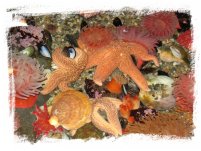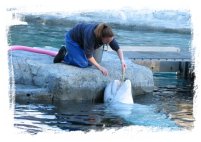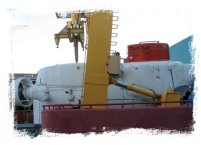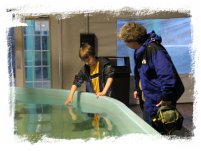Mystic Aquarium and Institue of Exploration
Wed-Friday November 8-10, 2006 We had skipped several aquariums on the trip – there are no shortage of top notch facilities near our home, including the brand new Georgia Aquarium in Atlanta. However, our ‘Hidden New England’ guidebook listed the Mystic Aquarium as an ‘Authors Favorite’, so we decided to give it a try on a rainy day.
We had skipped several aquariums on the trip – there are no shortage of top notch facilities near our home, including the brand new Georgia Aquarium in Atlanta. However, our ‘Hidden New England’ guidebook listed the Mystic Aquarium as an ‘Authors Favorite’, so we decided to give it a try on a rainy day.This proved to be a both a good idea and a bad one. The aquarium was well worth visiting, but……..most of it was outside! It was raining cats and dogs while we were there, which rather limited our ability to enjoy the outside exhibits, so we visited the indoor portion of the facility and decided to come back in a couple of days when the weather was supposed to improve.
 The aquarium is not large – inside, there are the typical exhibits of Rays, Piranhas, Sharks, and a nice touch tank full of lobsters, sea stars and crabs. There is an indoor sea lion show, reminiscent of those you might see at Sea World. What makes the aquarium stand apart, however, is that it is an active research facility. The Stellar Sea Lions are a particular focus area, with research ongoing into diet and vitamin concentrations in the animals. Feeding times for the marine life all around the aquarium are narrated presentations, with information provided about the training and research of the animals.
The aquarium is not large – inside, there are the typical exhibits of Rays, Piranhas, Sharks, and a nice touch tank full of lobsters, sea stars and crabs. There is an indoor sea lion show, reminiscent of those you might see at Sea World. What makes the aquarium stand apart, however, is that it is an active research facility. The Stellar Sea Lions are a particular focus area, with research ongoing into diet and vitamin concentrations in the animals. Feeding times for the marine life all around the aquarium are narrated presentations, with information provided about the training and research of the animals. We went back on a much sunnier day, and enjoyed the outdoor exhibits. The aquarium hosts 3 snow white Beluga Whales, and the tank, done up as an Alaskan Tundra area, is well done. One side has a long glass wall which allows underwater viewing of the whales. It’s a popular attraction at feeding time.
We went back on a much sunnier day, and enjoyed the outdoor exhibits. The aquarium hosts 3 snow white Beluga Whales, and the tank, done up as an Alaskan Tundra area, is well done. One side has a long glass wall which allows underwater viewing of the whales. It’s a popular attraction at feeding time. There is also a flock of African Penguins. These penguins do not like the cold – temperatures below freezing requires the aquarium to bring the birds inside. During feeding times, they track exactly what each penguin is fed, and how much they individually eat. Each penguin is identified by sex and name using beads clipped to a wing. Therefore, they go by ‘Green-Red”, “Silver-Blue”, etc….
There is also a flock of African Penguins. These penguins do not like the cold – temperatures below freezing requires the aquarium to bring the birds inside. During feeding times, they track exactly what each penguin is fed, and how much they individually eat. Each penguin is identified by sex and name using beads clipped to a wing. Therefore, they go by ‘Green-Red”, “Silver-Blue”, etc….For as ungainly as the Penguins are on land, they are bullets under water. Their swimming has been compared to flying underwater, and as the video below demonstrates, it’s an accurate description. When they decide to, they can move amazingly fast underwater.
 The real highlight of the aquarium is its affiliation with Robert Ballard. Ballard is best known as the discoverer of the Titanic. Using largely unmanned submersibles, Ballard has now tracked down a multitude of wrecked ships, including the Bismarck, the USS Yorktown, and the PT 109. A large exhibit at the aquarium highlights Ballard’s finds. It is split into roughly 3 sections – one on the PT 109 search, another for the Titanic, and a final exhibit on explorations in the Black Sea.
The real highlight of the aquarium is its affiliation with Robert Ballard. Ballard is best known as the discoverer of the Titanic. Using largely unmanned submersibles, Ballard has now tracked down a multitude of wrecked ships, including the Bismarck, the USS Yorktown, and the PT 109. A large exhibit at the aquarium highlights Ballard’s finds. It is split into roughly 3 sections – one on the PT 109 search, another for the Titanic, and a final exhibit on explorations in the Black Sea.Vance found the story of the PT 109 fascinating, particularly since we had visited the JFK Presidential Library just a couple of weeks ago. It took awhile before I could get him to understand how the PT109 was run over by a Japanese destroyer. He watched a WWII era video about the PT boats over and over, and got the idea that PT109 had been sunk in a battle. We had toured an American WWII era destroyer (USS Cassion Young) in Boston, and I think he finally got a concept how the little PT boat was crushed by the much larger Japanese vessel in the fog.
Concerning the 3rd Ballard exhibit - Ballard was looking for evidence of the ‘Black Sea Flood’, an event that may explain Noah’s Flood, as well as flood legends in other cultures. Several geologists have proposed a controversial theory that hypothesizes at the end of the last ice age, the Black Sea was a fresh water lake, separated from the Mediterranean by the landmass that is now under the Bosporus Strait. As the glaciers melted, approximately 8000 years ago, the water level of the oceans rose dramatically, eventually cresting the ridge blocking the way to the Black Sea, nearly 500 feet below. When the water broke thru, a huge flood occurred; likely lasting for months, until the water level had equalized.
In an expedition sponsored by National Geographic, Ballard was able to find evidence of this event, including markings of the ancient shoreline, and remains of fresh water shells. In addition, the team found an Phoenician ship dating sometime around 550 A.D. Because of the chemical makeup of the water, the wood from the ship remained largely intact, making this the oldest ship remains ever located!
 The aquarium is unique in that most of the marine wildlife is located in outside exhibits – it feels more like a zoo than an aquarium. The Ballard exhibit, which is constantly being updated, is fascinating. Although small, it was a neat visit.
The aquarium is unique in that most of the marine wildlife is located in outside exhibits – it feels more like a zoo than an aquarium. The Ballard exhibit, which is constantly being updated, is fascinating. Although small, it was a neat visit.
Vance: The Mystic Aquarium has many interesting animals. The first day we went there it was raining. We first had a look at the Beluga Whales. Next we went over to the penguins. These penguins are called Black Footed African penguins. These penguins only like warm weather. They had a few chicks among the penguins. There are only 3 species of penguins that live in Antarctica. In the next exhibit over they had a Sea Lion.
Later I had a little fun at the touch tank. One Blue Lobster was huge! At 3:30 we saw a show about Sea Lions. It turns out the aquarium had an electric eel. On Friday we had a much better time. We saw feedings with the Belugas, Sea lions, and a Ray feeding.
One exhibit was about Robert Ballard, the man who found the Titanic. The Titanic didn’t hit an iceberg head on, it hit the iceberg on the side. He uses small deep sea cameras to take pictures of the ships. He also found the PT 109, a PT boat John F. Kennedy was in charge of. It was hit by a Japanese destroyer. Ballard also found a ship from about 1500 years ago at the bottom of the Black Sea.
ONE OF THE COOLEST AQUARIUMS I’VE BEEN TO!









<< Home